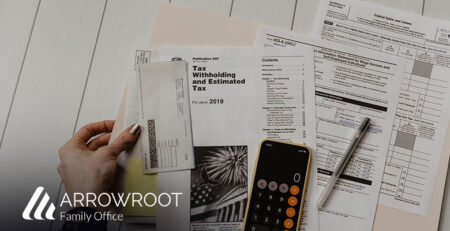Trust and Estate Planning: All You Need to Know

Estate planning is the process of creating a comprehensive plan that designates who will receive one’s estate and assets and who will be in charge of one’s responsibilities after death. It goes beyond the fundamentals of a will and involves more specific details like powers of attorney, establishing trust, and decreasing the taxable amount of your estate. Estate planning consists of the preparation of tasks that serve to manage an individual’s asset base, which involves the bequeathment of assets to beneficiaries and the proper settlement of estate taxes. Most estate plans are set up with the assistance of professional attorneys experienced in estate law.
- The main objectives of Estate Planning
- Importance of Estate Planning
- Setting up a Will
- Setting up a Trust
- Appointing the Right Executor
- Planning for Estate Taxes
- Estate Freezing
- Using Life Insurance in Estate Planning
- Advantages of Estate Planning
- How Can Arrowroot Simplify Your Estate Planning?
- FAQs
The main objectives of Estate Planning
The main objective of estate planning involves determining how an individual’s assets will be preserved, managed, and distributed after an individual’s death or in the event they become incapacitated. This also involves taking into account the management of an individual’s properties and financial obligations in the event that the specific individual becomes incapacitated or deceased. This could include tasks such as will creation, trust setup, charitable donations to limit estate taxes, naming an executor for the trust and naming beneficiaries, establishing a guardian for living dependents, creating and updating beneficiaries on different plans such as life insurance, IRAs, and 401(k) retirement plans, and setting up any needed funeral arrangements.
Assets that could make up an individual’s estate include houses, cars, stocks, artwork, life insurance, pensions, and debt. Individuals have various reasons for planning an estate, such as preserving family wealth, providing for a surviving spouse and children, funding children’s or grandchildren’s education, or leaving their legacy behind for a charitable cause.

Helping you achieve your evolving financial objectives
Importance of Estate Planning
Estate planning is vital in leaving a legacy behind for children or grandchildren. It is crucial to make sure all of your assets in your estate are adequately taken care of to make sure nothing happens to them in your absence. This also includes being mindful of different estate taxes that could potentially harm the worth of the legacy you leave behind to family members you love.
Setting up a Will
A will is a legal document created to provide instructions on how an individual’s property and custody of minor children, if any, should be handled after death. The individual expresses their wishes through the document and names a trustee or executor that they trust to fulfill their stated intentions. The will also indicate whether a trust should be created after death. Depending on the estate owner’s intentions, a trust can go into effect during their lifetime (living trust) or after their death (testamentary trust).
The authenticity of a will is determined through a legal process known as probate. Probate is the first step taken in administering the estate of a deceased person and distributing assets to the beneficiaries. When an individual dies, the custodian of the will must take the will to the probate court or to the executor named in the will within 30 days of the owner’s death. The probate process is a court-supervised procedure in which the authenticity of the will left behind is proved to be valid and accepted as the true last testament of the deceased. The court officially appoints the executor named in the will, which, in turn, gives the executor the legal power to act on behalf of the deceased.
Setting up a Trust
Trusts are legal arrangements that provide the necessary tools to transfer assets from an owner to a trustee. They set the terms for the trustee’s management of the assets and distributions to one or more designated beneficiaries. The trustee is a fiduciary or firm obligated to handle the assets in the trust in accordance with the terms provided in a will or trust document and solely in the best interests of the beneficiaries. Unlike wills, which take effect upon death, trusts can become effective during the asset owner’s lifetime. These trusts can often be altered, amended, or terminated at any time, depending on their type. A revocable trust can be changed and passed outside of probate. The owner retains control of their trust while alive, and their assets are included in the owner’s taxable estate. An irrevocable trust cannot be changed as the asset owner gives up ownership of their assets and transfers them over to the trust, one in which they do not control or alter the assets. The income from these assets is not included in the previous owner’s taxable income or a part of their estate.
Some other trusts available for setup can include charitable trusts and special needs trusts. Charitable trusts can be established for the life of one or more individuals or for a specified amount of years. This trust will support regular payments to charities until the trust’s term ends; then, the trust’s remaining assets will be distributed to the non-charitable beneficiaries and family members. Individuals concerned about the financial needs of those with disabilities or people unable to economically support themselves due to a disability can create a special needs trust. This will enable these individuals to continue to receive financial support from the trust without jeopardizing their eligibility for federal and state public assistance programs and other benefits.
Appointing the Right Executor
The legal personal representative or executor approved by the court is responsible for locating and overseeing all the assets of the deceased. The executor must estimate the estate’s value by collecting all assets under the deceased’s name. These assets could include retirement accounts, bank accounts, stocks and bonds, real estate property, jewelry, and any other items of value. The executor also has to pay off any personal taxes of the deceased and debt owed by the estate. After the inventory of the estate has been calculated, listed, and taken, the value of assets calculated, and taxes and debts paid off, the executor will then seek authorization from the court to distribute whatever is left of the estate to the various beneficiaries stated in your will.
Planning for Estate Taxes
Federal and state taxes applied to an estate can considerably reduce its value before assets are distributed to beneficiaries. Death can result in large liabilities for the family, necessitating generational transfer strategies that can reduce, eliminate, or postpone tax payments.
During the estate-planning process, there are significant steps that individuals and married couples can take to reduce the impact of these taxes. Married couples, for example, can set up an AB trust that divides into two after the death of the first spouse. A grandfather may encourage his grandchildren to seek college or advanced degrees and thus transfer assets to an entity, such as a 529 plan, for the purpose of current or future education funding. Another strategy an estate planner can take to minimize the estate’s tax liability after death is by giving to charitable organizations. These donations reduce the financial size of the estate since they are excluded from the taxable estate, thus lowering the estate tax bill.
Estate Freezing
This is another strategy that can be used to limit death taxes. It involves an individual locking in the current value, and thus tax liability, of their property or asset while attributing the value of future growth of that capital property to another person. Any increase that occurs in the value of the asset in the future is transferred to the benefit of another person, such as a spouse, child, or grandchild. This method involves freezing the value of an asset at its value on the date of the transfer in order to minimize estate tax contributions.
Using Life Insurance in Estate Planning
Life insurance serves as a source to pay death taxes, and various expenses and fund retirement plans. If sufficient insurance proceeds are available and the policies are properly structured, any income tax on the deemed dispositions of assets or any outstanding debt following the death of an individual can be paid without resorting to the sale of assets. Proceeds from life insurance that are received by the beneficiaries upon the death of the insured are generally income tax-free.
Advantages of Estate Planning
Estate planning is an ongoing process and should be started as soon as an individual has any measurable asset base. As life progresses and goals shift, the estate plan should align with new goals. Lack of adequate estate planning can cause undue financial burdens to loved ones (estate taxes can run as high as 40%). Picking out a proper executor, naming all beneficiaries, and detailing precisely what is included and not included in one’s estate plan gives the estate owner complete control of their assets to make the most appropriate financial decisions concerning family members.
Those who should receive ownership of certain assets and those who should not is an important matter to establish before death. The idea of making a will can raise uncomfortable conversations about death, especially at old age; however, these are conversations that must take place. Even if your assets are limited to just a single residence, a couple of bank accounts, and perhaps an IRA or 401(k) account, you still want to be sure that the people you wish to receive these assets do indeed become their owners and that your plans are executed with the greatest efficiency and least expense possible. If one were to die without a will, the post-mortem management and distribution of your assets, the handling of your debts, and the care of your young children and other dependents would be dependent upon the state’s intestacy law and an administrator appointed by the probate court to manage your estate. This means that these decisions will be out of your control. Generally, these laws allocate a significant portion of the estate to your surviving spouse and divide the remainder equally among your children. They do not consider factors that might influence you to divide your estate unequally among your heirs. A first step one could do with an estate is to set up a will while alive, even if the taxable estate is not large so that if an unexpected tragedy were to occur, one’s family will be given guidance and taken care of in the proper way to avoid any legal issues or personal disputes between family members. As one’s estate grows and changes over time, so would the will, as it can be changed and revised at any given time.
How Can Arrowroot Simplify Your Estate Planning?
Arrowroot Family Office provides estate planning services that are simple and effective, allowing you to live in peace knowing that everything will be taken care of for you. Arrowroot Family Office was created to bring a solution to the complex financial and investment lives of many families. Arrowroot Family Office helps in estate planning by optimizing asset reporting to minimize estate taxes on one’s estate. We do this by combining certified public accountancy experience with cutting-edge tax planning techniques. Arrowroot Family Office identifies the most effective approach when creating a will or trust to leave assets to your beneficiaries in the most optimal way possible. We will also make sure to find the perfect executor that fits your needs and requirements. We will provide a capable power of attorney for all finance inquiries to take the burden off of your hands and make your life a little bit easier. Arrowroot Family Office advisors are committed to looking out for your needs and your best interests. We will help make sure that your wishes are followed in all steps of the process to avoid any legal issues or personal disputes between family members, ensuring a smooth experience.







Leave a Reply